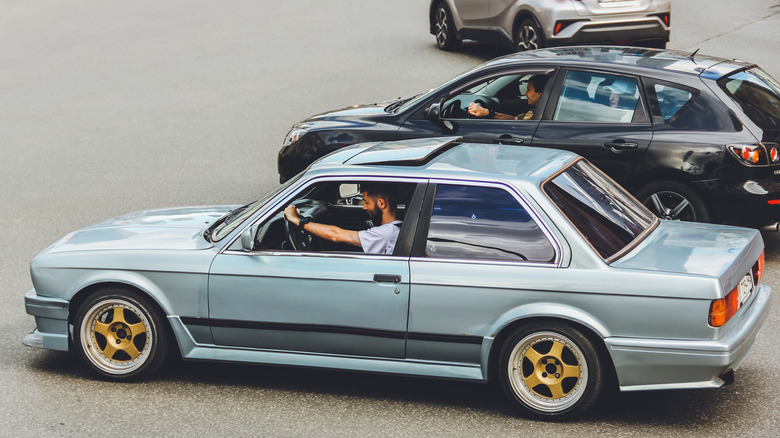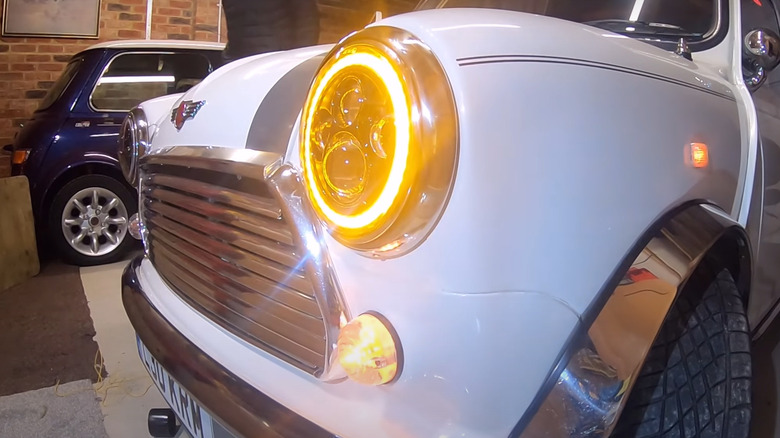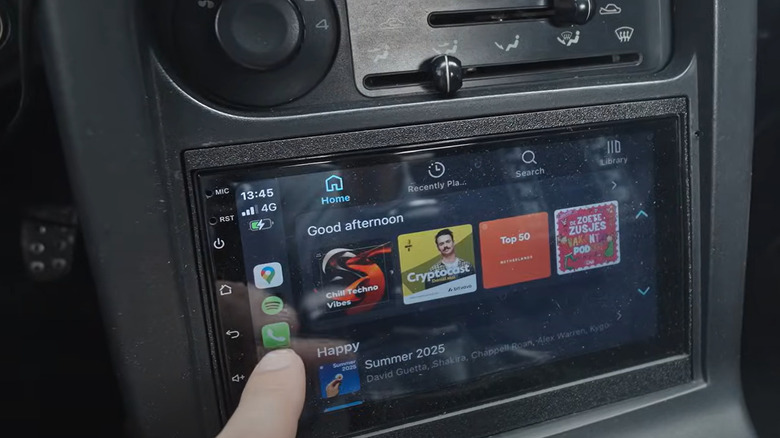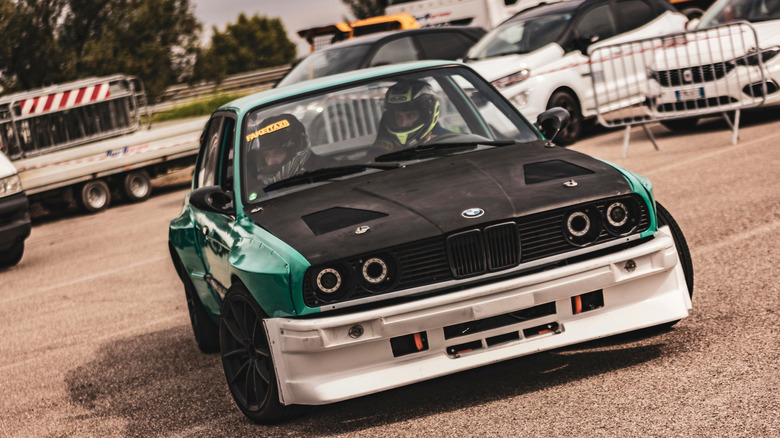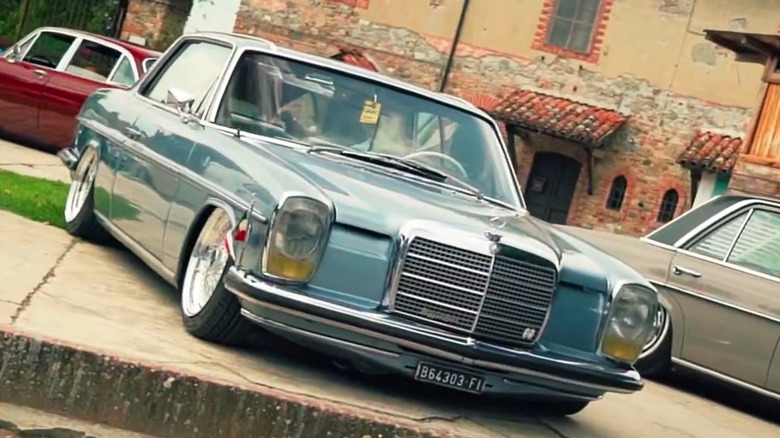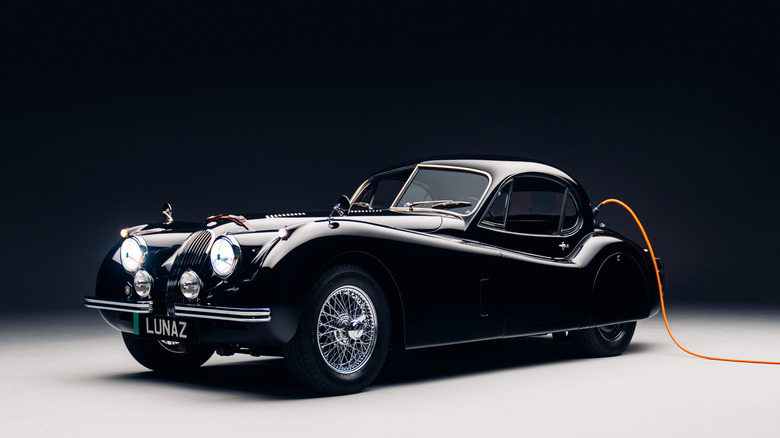5 Modern Upgrades That Will Destroy The Value Of Your Classic Car
Owning and daily driving a classic car isn't for everyone. Sure, there are positives to buying a model from yesteryear, such as the overwhelming feel of nostalgia, and the joy of polishing chrome up on a Sunday afternoon, but these cars bring with them a number of serious drawbacks too. Constant oil leaks, snail-like pace, and questionable reliability are but a few of the common quirks of classic cars. With that being said, certain modern upgrades — like switching to electronic ignition, or even introducing electronic fuel injection – can help to counter some of the reliability concerns of classic car ownership. Such modifications may even help you to sell the car on for a better price, too.
However, not all modern modifications to classic cars are looked upon kindly, and installing them upon your treasured ride could actually result in a reduced price when it comes to selling on. As an ex-classic car dealer, and as someone who's always got at least one (or two, or three) classic or vintage cars in their possession, I've seen first-hand which modifications make a classic either easier or more difficult to sell.
At this point, it's worth emphasizing that the quality of a modification often matters more than the modification itself. For example, if you've painted your classic Mustang with a rattle can in the garage, this will likely damage the value massively. However, if it's had a glass-out respray in a professional booth, expect to see the value soar accordingly. This is true for many, if not most modifications, as we'll see below.
Aftermarket lighting
This is one which is likely to ruffle feathers, as unlike some modifications — such as neon underglow lights or loud exhausts — this could easily be passed off as a safety upgrade. Nevertheless, swapping out your classic car's original headlamps for aftermarket LED headlights is likely to damage the resale value, depending upon a few factors.
For starters, if the lights are dramatically different from standard, such as LED Halo lights, or custom units which allow for different colors and/or flashing patterns, it's these which are more likely to affect your classic's value. If, however, they closely resemble the original car's aesthetic, then the chances are the value won't be affected. While bright lights could dramatically improve visibility for both the driver and oncoming traffic in poor conditions, the simple fact of the matter is that aftermarket lights alter the look of classic cars, and this can detract from the feeling of nostalgia buyers may feel.
Many classic car buyers purchase with their heart, rather than their head, and if the car they're looking at no longer resembles the model they have in their head, it's less likely to pull on their heart strings. The lesson here is, while there are many sensible reasons to upgrade classic car lighting, don't forget to store the original components. Then, consider swapping them back in when it comes time to sell, as the majority of buyers will want their classic purchase to be bone-stock.
Retrofitting modern amenities
At first, retrofitting modern kit into a classic car may seem to make a lot of sense. Often, amenities such as electric windows, Bluetooth phone connectivity, and GPS navigation systems are taken for granted in new cars, but when behind the wheel of anything classic, the lack of any technology to assist you becomes immediately apparent. Amenities like this can usually be retrofitted very easily, with comprehensive kits providing everything you need. This is great if you're looking to daily drive your classic, and need some modern comforts, but it's likely to be detrimental if preserving your classic's value is of serious interest.
This is because most people search out classics to be their second car, a weekend toy, or just something to tinker with and transport them back to simpler times. The chances are they already have a modern car, brimming with every gizmo and gadget imaginable, and their weekend classic is meant to be an escape from this. Driving a car which has nothing more than windscreen wipers and a mechanical air vent is wonderfully enticing, and it's this original and era-transporting experience that buyers are more frequently searching for in 2025.
I should add that adding period-correct extras and options should not be tarnished with the same brush. For example, retrofitting an in-built phone to your '90s S-Class is pretty cool, as is fitting that optional heater to your 1960s Triumph, and modifications like this can often add to your car's value — particularly if the factory-fitted add-ons are now scarce.
Body modifications
While there are solid arguments for wanting to carry out the aforementioned modifications, there really is little cause to butcher a classic car by removing its bright chrome bumpers, and instead installing widebody vehicle kits, unnecessary spoilers, and fake cooling vents. However, tastes vary, and the world would be a very boring place if we all liked the same things. Regardless of your personal preferences though, the truth is that big body kits and aftermarket spoilers are hugely detrimental to a car's value.
Sure, if you've got a beautiful restomod which has benefitted from a monster restoration, the opposite might be true. However, generally speaking, well-preserved and original examples are going to be worth considerably more than what a cosmetically modified classic would ever fetch. That's not even the worst part, as not only do you miss out on resale value, but you've had to endure the cost of buying, prepping, and painting that unsightly body kit too.
Stanced and slammed suspension
This one is perhaps one of the more obvious entries in this list of value-damaging modifications, and should come as no surprise to most enthusiasts. While adding sports or uprated suspension packages can improve a car's value, and really enhance the handling of an otherwise cumbersome classic, slamming it to the ground and introducing as much negative camber as possible is not the way to go about things if future value is something you care about. Cars with this aesthetic certainly do have their place within the show scene, and that's absolutely fine, as once again the world would be a dull place if we all wanted our classics to look the same.
However, expecting the next enthusiast to want this look is a mistake to make. The truth is you'll be losing out on the money you spent acquiring the look, and then losing out in terms of values too, when compared to an otherwise standard example. It's worth remembering that slammed and stanced cars are actually illegal in some states, too, which may significantly narrow the pool of interested buyers when it does come time to sell.
EV conversions
Converting your beloved classic to run solely on electric power won't exactly destroy the value, but it will leave you tens-of-thousands worse off than if you'd just left it alone — or at least that's what most experience. Take this BMW 700, as an example — it's currently advertised for just shy of £50,000 (approximately $66,771 USD) in the U.K. right now, but it failed to sell for even a fraction of this at auction multiple times both last year and earlier this year. Not only did the restoration cost £37,000 ($49,411 USD), but the EV conversion also set the previous owner back £28,000 ($37,392 USD), resulting in a huge net loss even if it did manage the unlikely asking price of £49,995 ($66,765 USD). For reference, a smart and standard BMW 700 typically changes hands for around $32,000.
The BMW isn't alone, either, as a late '80s Land Rover Defender demonstrates. It's currently advertised, again in the U.K., for a seemingly reasonable £29,995 ($40,050 USD). That's not an unusual price to see associated with the model, but £43,000 ($57,413 USD) in EV conversion bills is unusual, and will leave the seller with a considerable net loss overall — and that's not even considering the original purchase price paid for the Defender prior to the conversion. As a passion project, converting your classic into an EV could be an exciting and worthwhile endeavor — just don't expect the next owner to be as willing to spend even close to what you did in achieving the finished product.
